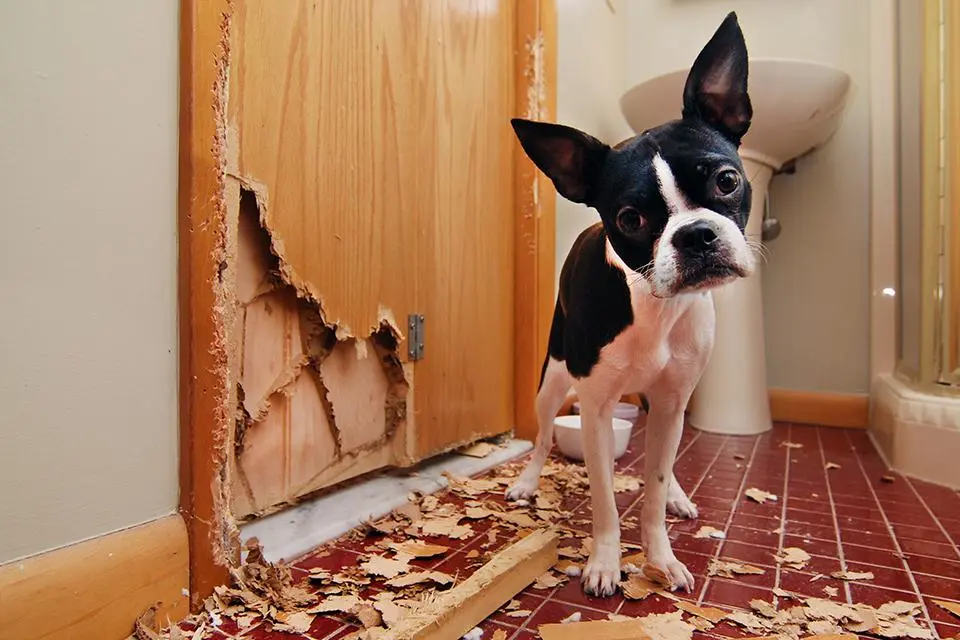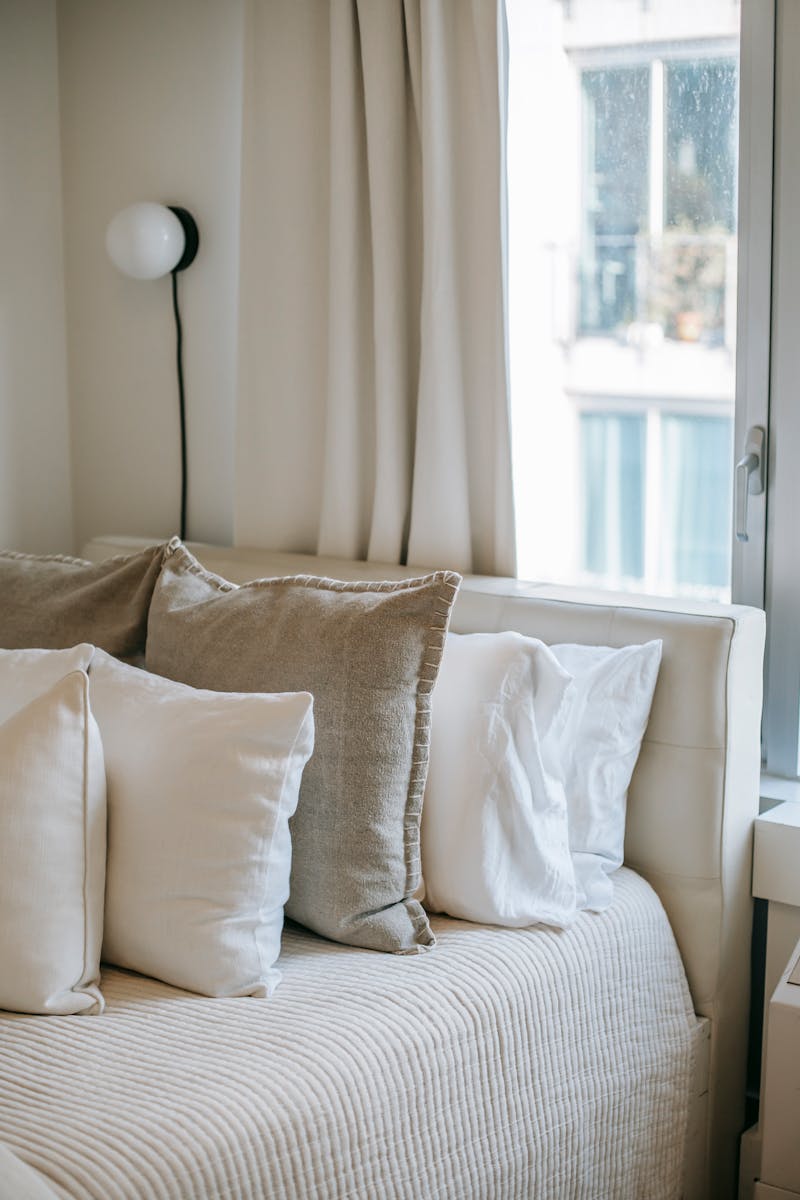
How Long Can Dogs Be Left Alone

How Long Can Dogs Be Left Alone
Most people don’t really know how long can dogs be left alone, most people just wing it, but on this article we’re going to go in dept in this topic so keep reading.
While it varies among breeds and individual dog temperaments, generally, adult dogs shouldn’t be left alone for more than six to eight hours, ensuring the canine’s physical and emotional well-being is prioritized.
| Dog Age | Time Alone |
|---|---|
| Puppy (Under 6 months) | 1 – 3 hours |
| Young Adult (6 months to 18 months) | 4 – 6 hours |
| Adult Dog (18 months and older) | 6 – 10 hours |
| Senior Dog | Varies depending on health |
Specific Ages
Puppies under six months of age are not physically capable of controlling their bladders for more than 1 – 3 hours. Besides, puppies are also mentally incapable of being left alone for long periods as they’re used to the constant companionship in their litter. If left alone for too long, a young puppy may become anxious and start showing signs of destructive behavior.
Young adults, those between six and eighteen months of age, have somewhat mature bodies and can hold their bladder for about 4 – 6 hours. This is the stage where separation anxiety might kick in if they do not get regular exercise, mental stimulation, and interaction with people or other animals. Too much alone time can lead to destructive behaviors such as chewing furniture or scratching doors.
Moving to adult dogs, once they reach the age of 18 months and above, dogs are physically mature and can hold their bladder for 6 – 10 hours. Nevertheless, this doesn’t mean that it’s okay to leave them alone for this long consistently. They require physical and mental stimulation to stay happy and healthy. Without these, they may resort to unwanted behaviors out of boredom and loneliness.
Lastly, the amount of time a senior dog can be left alone really depends on their health. Some older dogs might struggle with holding their bladder for long periods and might need more frequent trips outside. Also, older dogs might experience increased levels of anxiety when left alone.
To sum up, the appropriate duration to leave dogs alone varies with their age, health condition and psychological needs. In the perfect world, dogs should not be left alone for extended timeframes. True to the quote by Roger Caras “Dogs are not our whole life, but they make our lives whole”, we have to consider giving dogs the attention and care they need as much as we can.
For more nuanced guidance tailored to specific breeds, sizes, and individual dogs’ health conditions – always feel free to consult with a trusted veterinarian or professional dog trainer.
Reference: [American Kennel Club](https://www.akc.org/expert-advice/training/how-long-can-you-leave-a-dog-alone/).
Understanding the Factors Influencing a Dog’s Alone Time

Dog Home Alone
Your shaggy, tail-wagging best friend doesn’t have to be Sherlock Holmes to grasp when you’re preparing to leave for work, and it most likely fills them with anxiety. Indeed, “I’ll be back soon!” sometimes comes across as just an empty reassurance in our pet’s eyes. This begs the question for many dog owners, “How long can dogs be left alone?”
Taking into account the multifarious factors and dimensions from a dog’s age, health status, temperament, breed characteristics, and even your individual dog’s personality, the dog training process is critical to helping address this concern:
Breed Characteristics
Different breeds have different needs. Working or hunting breeds such as Border Collies or Beagles are prone to being active, so extensive amounts of time alone could lead to destructive habits. Family-friendly breeds like Golden Retrievers fare slightly better; yet, their need for socialization still holds them back from lengthy periods of aloneness. Essentially, knowing your breed is a pivotal tool in comprehending how much alone time they can tolerate.
Age and Health Status
Puppyhood and old age play crucial roles in understanding how long dogs can stay alone. Puppies generally require constant supervision due to their higher energy levels and lack of training, while older dogs might require frequent vet trips or medication, implying they can’t be left alone for extended periods either.
Individual Dog’s Temperament
Just like humans, each dog has its unique personality. Some pups may handle alone time quite well, while others may suffer from Separation Anxiety, a condition characterized by excessive distress when separated from their human companions.
Alice Walker once said, “Dogs are always going to surprise you.” Their adaptable nature and devotion to their human counterparts make them resilient creatures.
Incorporating Training Regimes
Incorporating crate training early on provides a safe space for your canine companion during lonely hours—further reducing stress and potential damage caused by anxiety.
Gradual desensitization training can also aid dogs with separation anxiety. It involves gradually increasing the amount of time they spend alone, acclimatizing them to longer departures progressively.
Last but not least, enlisting professional help can undoubtedly work wonders. Dog trainers or behaviorists trained in separation anxiety cases can provide personalized solutions tailored specifically to your beloved pet’s needs.
To maximize your furry friend’s comfort during your necessary absences, the integration of multiple strategies alongside proper understanding of unique needs is undeniably essential. Remember that patience, plenty of practice, and love is a prerequisite when dealing with ‘alone’ training. Always prioritize their comfort over everything else when determining how long your dog should be left alone.
Tips for Gradually Increasing Your Dog’s Comfort with Solitude

If your pup pal suffers from separation anxiety or simply isn’t used to being alone, building their comfort and independence gradually is critically important. Here are some valuable dog training tips for increasing your pet’s comfort with solitude, all while relating to the question: “How Long Can Dogs Be Left Alone?”:
Increase Your Dog’s Alone Time Gradually
Rushing things would not be beneficial for either you or your dog. Nudge their ‘alone time’ forward in small increments instead, adjusting it according to their level of comfort.
- Start Small:Begin by leaving your dog alone for just a few minutes at a time. You can increase this gradually as your dog becomes acclimated to periods of solitude.
- Pay attention to your dog’s behavior:Every dog is different. Some might find a few hours of solitude refreshing, while others may become anxious after just an hour. Understand their limits and respect them.
Create a Safe and Comfortable Environment
The environment where your dog spends their alone time can significantly impact their comfort levels.
- Provide cozy bedding:Be sure your dog has comfortable places to rest while you’re away. Ensuring their favorite bed or blanket is available can foster feelings of security.
- Engaging Toys: Tiresome loneliness can easily take over if your dog is left with nothing to occupy their mind. Toys that engage your dog mentally can help alleviate stress and distract them from your absence. Consider toys like KONG, puzzle mats or treat-dispensing toys.
Use Positive Reinforcements
Building a positive association with you leaving the house can fundamentally change how your dog perceives solitude.
- Treat Associations: Give your dog their favorite treat right before leaving your house. Over time, your dog will associate your departure with something positive.
- Doggy Daycare: Not every dog can handle long hours of solitude, and that’s okay! For those long workday situations where your dog’s alone time exceeds their comfort level, consider utilizing a doggy daycare. While it’s not technically solitude, it helps in maintaining routine and comfort levels.
In the words of Kevin O’Leary, “What dogs teach us is very primal: trust, love, loyalty, comfort, and the amazing ability of another living creature to be able to soothe your soul.” Even though teaching our pets to spend time alone is necessary, it’s equally vital that we are always there for them as they are for us.
Exploring Solutions to Effectively Manage Your Dog’s Alone Time

Managing your dog’s alone time can be a tricky business, especially when looking at how long dogs can be left alone. It all boils down to their age, health and personality type. Dogs are social animals by nature which means they thrive on interaction with us, human beings. Ensuring your dog gets adequate time with you, balanced with independent playtime and rest, is essential.
Understanding Alone Time for Different Dog Ages
Puppies require consistent attention because of their high energy levels and the need for guidance in terms of house training. It’s generally unwise to leave puppies under six months alone for more than two hours. Adult dogs that are between one to eight years old, depending on their health and breed, can manage being alone for about 6-8 hours. Senior dogs, just like the puppies, require more care and should not be left alone for significant period of time (source).
Solutions for Managing Your Dog’s Alone Time
- Create a Safe Space: Set up a comfortable, chew-proof space within your home in your absence. Ensure it’s well-ventilated, free from hazardous materials, and has plenty of fresh water.
- Puzzle Toys: These are great for mental stimulation and keeping them entertained when you’re not present. Stuffing a Kong toy with their favourite food will keep them busy for a substantial amount of time.
- Dog Walkers or Pet Sitters: They can provide companionship and physical activity if you’ll be away for an extended time. Services such as Rover offer real-time updates on your pet via their app.
- Doggie Day Care: Just as it sounds, these are day care centres for dogs to interact with other dogs under the supervision of trained professionals.
“No one appreciates the very special genius of your conversation as the dog does.” – Christopher Morley. This quote pinpoints the importance of our presence in our dog’s lives. It reminds us that while there are ways to manage your dog’s alone time effectively, nothing quite replaces the companionship and love they get from spending time with us.
Mitigating Separation Anxiety
If your dog shows signs of intense stress when you’re going to leave or already absent — excessive barking, pacing, or destructive behavior — they may have separation anxiety. Consult with a vet or a professional dog trainer to come up with a strategy to counter this issue. Separation anxiety can be managed through a variety of techniques, including gradual acclimation to your departure, creating positive associations with your leaving, and possibly medication in severe cases (source).
In conclusion, managing your dog’s alone time effectively is a crucial element in maintaining a healthy and strong bond with your four-legged companion. Implementing engaging toys, hiring help, using doggy daycare and acknowledging any unprecedented separation anxiety symptoms helps ensure they are happy and secure in their environment during those periods of solitude.
Understanding The Solo Time Limit For Dogs
In essence, the length of time a dog can be left alone varies based on their age, health, and emotional well-being. Younger dogs and puppies often require more attention and frequent treat times while older dogs with established routines may tolerate longer periods without company. You might find it helpful to think about key factors such as your dog’s breed, personality, and overall health in conjunction with their need for food, water, bathroom breaks, exercise, and socialization.
However, given that dogs are inherently social creatures, leaving them alone for long periods can lead to damaging behaviors. Loneliness and boredom can push dogs into destructive behaviors like chewing, digging, or excessive barking (American Kennel Club).
A Dog-Friendly Daily Schedule
The ideal scenario would be never leaving your canine companion alone for more than 4 hours per day. This time period gives you the flexibility to meet all their essential needs without causing undue stress:
– Regular feeding times
– Adequate hydration
– Regular bathroom breaks
– Exercise and playtime
– Social interaction
However, reality seldom allows such a perfect schedule. If circumstances necessitate longer absences consider enlisting the help of a professional dog walker or trusted neighbor to check in on your pet and provide essential care.
Remember also that smart technology exists to alleviate some of this burden. Products like automated food dispensers and water fountains ensure that nutrition doesn’t miss a beat even when humans do!
Keeping Your Dog’s Wellbeing in Mind
Leaving your dog alone is an unavoidable part of living in today’s fast-paced world but striking a balance between necessity and your dog’s wellbeing will set the stage for happiness on both ends of the leash. As author Dean Koontz said, “Once you have had a wonderful dog, a life without one, is a life diminished.” Ensuring our dogs aren’t left alone excessively goes a long way towards enriching both their lives, and ours. Your diligent scrutiny of the clock today leads to a happy tail wagging tomorrow!
Related
- Can A Dog Wear A Collar And A Harness At The Same Time
- What Are The 7 Obedience Commands for Dogs
- Can a Dog Live 20 Years
You may also like

What Country Has The Most Homeless Dogs

Why Do Dogs Let Cats Bully Them

What Is The Russian Version Of German Shepherd
Archives
- December 2025
- November 2025
- October 2025
- September 2025
- August 2025
- October 2023
- September 2023
- August 2023
- July 2023
- June 2023
- May 2023
- April 2023
- March 2023
- February 2023
- January 2023
- December 2022
- November 2022
- October 2022
- September 2022
- August 2022
- June 2022
- May 2022
- April 2022
- March 2022
- January 2022
- December 2021
- November 2021
- October 2021
- August 2021
- November 2020
- July 2020
- May 2020
- April 2020
- March 2020
- August 2018
- July 2018
- June 2018
- April 2018
- March 2018
Calendar
| M | T | W | T | F | S | S |
|---|---|---|---|---|---|---|
| 1 | 2 | 3 | 4 | |||
| 5 | 6 | 7 | 8 | 9 | 10 | 11 |
| 12 | 13 | 14 | 15 | 16 | 17 | 18 |
| 19 | 20 | 21 | 22 | 23 | 24 | 25 |
| 26 | 27 | 28 | 29 | 30 | 31 | |
Categories
- Aftercare Procedures
- Age Groups
- AI/ML
- Alternative Medicine
- Animal Health
- Animal Husbandry
- Animals
- Anti-Aging
- Architectural Design
- Art And Technology
- Auditory Science
- Augmented Reality
- Automation
- Babies
- Baby
- Beauty & Skincare
- Biohacking
- Biomechanics
- Book Reviews
- Breastfeeding
- Budgeting
- Budgeting Strategies
- Business
- Cardiovascular Health
- Career Advice
- Career Development
- Career Growth
- Cats
- Chess
- Chronobeauty
- Circular Economy
- Cleaning Tips
- Cloud Computing
- Cognitive Health
- Cognitive Performance
- Cognitive Science
- Community
- Community Building
- Community Engagement
- Community Living
- Computer Vision
- Consumer Guides
- Consumer Trends
- Container Gardening
- Content Analysis
- Content Non-Technical
- Content Strategy
- Cosmetic Chemistry
- Cultural Events
- Cycling
- Data Analysis
- Data Engineering
- Data Science
- Database
- Design Psychology
- Design Trends
- Developer Productivity
- Diet
- Diet
- Digital Identity
- Digital Media
- Digital Wellbeing
- DIY Projects
- Dogs
- Engineering Culture
- Entertainment News
- Environmental Impact
- Environmental Science
- Equity Compensation
- Ethical AI
- Exercise
- Exercise Science
- Exercise Technique
- Exotic Pets
- Fall Gardening
- Family
- Family Health
- Family Life
- Fashion Business
- Fashion Industry
- Fashion News
- Fashion Tech
- Financial Analysis
- Financial Optimization
- Financial Planning
- Flooring Maintenance
- Food
- Food Psychology
- Food Safety
- Food Tech
- Functional Fitness
- Functional Training
- Future Of Work
- Garden Care
- Garden Maintenance
- Gardening Tips
- Gig Economy
- Greece
- Greek
- Greek Food
- Green Technology
- Gymnastics
- Hardware Engineering
- Health
- Health And Wellness
- Health Informatics
- Health Science
- Health Tech
- Healthcare Management
- Healthy Eating
- Healthy Recipes
- Holistic Health
- Holistic Wellness
- Home & Living
- Home Decor
- Home Financing
- Home Health
- Home Improvement
- Home Organization
- Home Styling
- Horticulture
- Identity Management
- Industrial Design
- Industry Analysis
- Infant Nutrition
- Infrastructure Management
- Ingredient Deep Dive
- Integrative Health
- Integrative Medicine
- Interior Design
- Internet of Things
- Internet of Things (IoT)
- Invalid Request
- Investment Strategies
- Investment Strategy
- IoT
- Kids
- Leadership Development
- Learning Strategies
- Lifestyle
- Lifestyle Brands
- Lifestyle News
- Lifestyle Optimization
- Literary Criticism
- Literature
- Logistics Management
- Material Science
- Materials Science
- Meal Planning
- Media Analysis
- Meditation
- Mental Health
- Mental Performance
- Mental Wellness
- Miami
- Miami Food
- Mind And Body
- Minimalism
- Mobile Development
- Neuroscience
- No Applicable Categories
- Nutrition
- Nutrition News
- Open Source
- Operating Systems
- Operational Resilience
- Opinion
- Organization Tips
- Outdoor Living
- Over 40
- Over 50
- Over 60
- Parenting
- Parenting
- Parenting Strategies
- Performance
- Performance Optimization
- Personal Development
- Personal Finance
- Personal Growth
- Personal Productivity
- Pet Care
- Pet Safety
- Philosophy
- Politics
- Productivity
- Productivity Engineering
- Protein
- Psychology
- Psychology of Space
- Reading Culture
- Real Estate Investment
- Recipes
- Regulatory Compliance
- Remote Work
- Renovation Planning
- Resource Management
- Respiratory Health
- Responsible Pet Ownership
- Retail Strategy
- Robotics
- Science
- Seafood
- Seasonal Gardening
- Security
- Sedentary Health
- Self-Care
- Skincare Science
- Skincare Trends
- Sleep
- Sleep Health
- Smoothies
- Social Impact
- Soft Skills
- Soil Health
- Spatial Computing
- Spatial Design
- Stress Management
- Supplements
- Sustainability
- Sustainability Science
- Sustainable Engineering
- Sustainable Fashion
- Systems Engineering
- Tax Optimization
- Tax Strategy
- Tech Investment
- Travel
- Travel News
- Travel Safety
- Travel Tips
- Trend Analysis
- Uncategorized
- Urban Planning
- User Experience
- Veggie
- Vietnam
- Virtual Events
- Volunteering
- Wealth Management
- Wearable Technology
- Wellness
- Wellness Technology
- Winter Gardening
- Work-Life Balance
- Workplace Culture
- World
- Writing
- Writing Skills
- Year In Review
- Yoga News
- Zero Waste

Leave a Reply